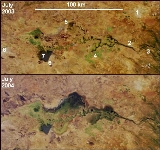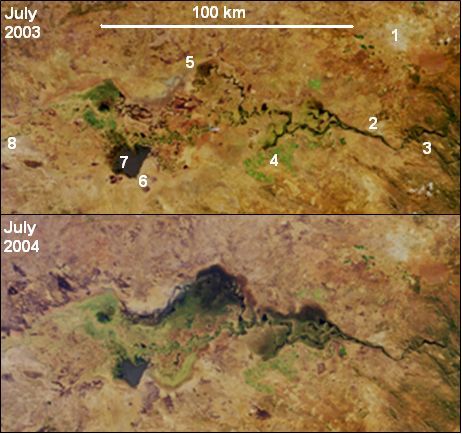
Itezhi-Tezhi Dam
Encyclopedia
The Itezhi-Tezhi Dam on the Kafue River
in west-central Zambia
was built between 1974 and 1977 at the Itezhi-Tezhi Gap, in a range of hills through which the river had eroded a narrow valley, leading to the broad expanse of the wetlands known as the Kafue Flats. A small town
has sprewn up near the dam.
including the only road within the park from the south to the centre and north. Formerly this provided a very good game drive close to the west bank of the river, now a longer road outside the park on the east side and further from the river, has to suffice.
The initial purpose of the dam is to store water for the hydroelectric power station
of the Kafue Gorge Dam more than 260 km downstream. The Kafue River, like most in south-central Africa, has a very high seasonal variation, flooding in the rainy season and slowing to perhaps a twentieth of the peak flow rate at the end of the dry season. Power generation however requires a steady flow, which can only be achieved by having a reservoir
large enough to store the rainy season flood for use in the dry season. At the Kafue Gorge the topography
does not allow a large enough reservoir to form. The designers of the dam therefore had the idea of siting the main reservoir at Itezhi-Tezhi, and releasing the water in a steady flow down the river along the Kafue Flats to the Kafue Gorge Dam.
 The designers of this scheme seemed to view the peak of the flood in March–April, and the great drying out in October–November, as some kind of disaster in need of a solution. The problem with this view is that the Kafue Flats ecosystem
The designers of this scheme seemed to view the peak of the flood in March–April, and the great drying out in October–November, as some kind of disaster in need of a solution. The problem with this view is that the Kafue Flats ecosystem
has evolved in response to these conditions, to regular extremes of flooding and drying out, and was well able to cope with them. The flood charges the soil with water. Fish, and animals adapted to swim or wade, help spread nutrients, and when the waters recede, grasses grow rapidly and sustain herbivores such as buffalo, lechwe
, and cattle
. The natural seasonal cycle has been fairly dependable and plants, fish, animals have adapted to the March–April inundation in their nutrition and breeding. So have the people who depend on them, and they move their settlements annually to cope with the regular cycle of flooding.
The dam removes the peak of the flooding and the trough of low water in the dry season. It reduces the natural seasonal variation of the river flow. The designers intended the dam would 'open the floodgates' for the whole of March and allow a flow of 300 m³/s to flood the flats to maintain natural cycles. However this has not happened in practice, mainly because the reservoir has not had sufficient water in it at the right time to sustain such a flow. The demand for electric power takes priority, and compounded by erratic rainfall since 1990, the dam has allowed flooding at the wrong time, or it has not been of sufficient duration or has not allowed some areas of the flats to dry out.
The Itezhi-Tezhi Dam has had these negative effects on the ecology
of the Kafue Flats:
The 2003/4 rainy season was particularly wet in Zambia and the dam did allow the flats to flood. The effect is shown in the NASA photos. According to a NASA website, in June 2004 an agreement was made with the hydroelectricity company to restore water releases from the dams according to a more natural flooding regime, prsumably by keeping to the original intention of a 300 m²/s flood for the whole of March.
Kafue River
The Kafue River sustains one of the world's great wildlife environments. It is a major tributary of the Zambezi, and of Zambia's principal rivers, it is the most central and the most urban, and the longest and largest lying wholly within Zambia....
in west-central Zambia
Zambia
Zambia , officially the Republic of Zambia, is a landlocked country in Southern Africa. The neighbouring countries are the Democratic Republic of the Congo to the north, Tanzania to the north-east, Malawi to the east, Mozambique, Zimbabwe, Botswana and Namibia to the south, and Angola to the west....
was built between 1974 and 1977 at the Itezhi-Tezhi Gap, in a range of hills through which the river had eroded a narrow valley, leading to the broad expanse of the wetlands known as the Kafue Flats. A small town
Itezhi-Tezhi
Itezhi-Tezhi is a small town in the northwestern part of Southern Province, Zambia. It lies west of the town of Namwala.Itezhi-Tezhi came into existence when the Itezhi-Tezhi Dam was constructed on the Kafue River in the early 1970s. The dam was created to hold and regulate the water flow in the...
has sprewn up near the dam.
Dimensions and purpose
The dam has a height of 62 m, a crest length of 1800 m and forms a reservoir of 390 km², which flooded part of Kafue National ParkKafue National Park
Kafue National Park is the largest national park in Zambia, covering an area of about 22,400 km² . It is the second largest park in Africa and is home to over 55 different species of animals....
including the only road within the park from the south to the centre and north. Formerly this provided a very good game drive close to the west bank of the river, now a longer road outside the park on the east side and further from the river, has to suffice.
The initial purpose of the dam is to store water for the hydroelectric power station
Power station
A power station is an industrial facility for the generation of electric energy....
of the Kafue Gorge Dam more than 260 km downstream. The Kafue River, like most in south-central Africa, has a very high seasonal variation, flooding in the rainy season and slowing to perhaps a twentieth of the peak flow rate at the end of the dry season. Power generation however requires a steady flow, which can only be achieved by having a reservoir
Reservoir
A reservoir , artificial lake or dam is used to store water.Reservoirs may be created in river valleys by the construction of a dam or may be built by excavation in the ground or by conventional construction techniques such as brickwork or cast concrete.The term reservoir may also be used to...
large enough to store the rainy season flood for use in the dry season. At the Kafue Gorge the topography
Topography
Topography is the study of Earth's surface shape and features or those ofplanets, moons, and asteroids...
does not allow a large enough reservoir to form. The designers of the dam therefore had the idea of siting the main reservoir at Itezhi-Tezhi, and releasing the water in a steady flow down the river along the Kafue Flats to the Kafue Gorge Dam.
Power station
The Zambian power company ZESCO is in the process of building a power station at the dam. The capacity of the station is planned to be 120 MW generated by two machines, costs are estimated to US$ 275-million and construction should be completed by 2013.Environmental impact of the dam on the Kafue River Flats

Ecosystem
An ecosystem is a biological environment consisting of all the organisms living in a particular area, as well as all the nonliving , physical components of the environment with which the organisms interact, such as air, soil, water and sunlight....
has evolved in response to these conditions, to regular extremes of flooding and drying out, and was well able to cope with them. The flood charges the soil with water. Fish, and animals adapted to swim or wade, help spread nutrients, and when the waters recede, grasses grow rapidly and sustain herbivores such as buffalo, lechwe
Lechwe
The Lechwe, or Southern Lechwe, is an antelope found in Botswana, Zambia, south-eastern Democratic Republic of the Congo, north-eastern Namibia, and eastern Angola, especially in the Okavango Delta, Kafue Flats and Bangweulu Swamps....
, and cattle
Cattle
Cattle are the most common type of large domesticated ungulates. They are a prominent modern member of the subfamily Bovinae, are the most widespread species of the genus Bos, and are most commonly classified collectively as Bos primigenius...
. The natural seasonal cycle has been fairly dependable and plants, fish, animals have adapted to the March–April inundation in their nutrition and breeding. So have the people who depend on them, and they move their settlements annually to cope with the regular cycle of flooding.
The dam removes the peak of the flooding and the trough of low water in the dry season. It reduces the natural seasonal variation of the river flow. The designers intended the dam would 'open the floodgates' for the whole of March and allow a flow of 300 m³/s to flood the flats to maintain natural cycles. However this has not happened in practice, mainly because the reservoir has not had sufficient water in it at the right time to sustain such a flow. The demand for electric power takes priority, and compounded by erratic rainfall since 1990, the dam has allowed flooding at the wrong time, or it has not been of sufficient duration or has not allowed some areas of the flats to dry out.
The Itezhi-Tezhi Dam has had these negative effects on the ecology
Ecology
Ecology is the scientific study of the relations that living organisms have with respect to each other and their natural environment. Variables of interest to ecologists include the composition, distribution, amount , number, and changing states of organisms within and among ecosystems...
of the Kafue Flats:
- fish production has significantly declined;
- wildlife such as LechweLechweThe Lechwe, or Southern Lechwe, is an antelope found in Botswana, Zambia, south-eastern Democratic Republic of the Congo, north-eastern Namibia, and eastern Angola, especially in the Okavango Delta, Kafue Flats and Bangweulu Swamps....
and SitatungaSitatungaThe situtunga or marshbuck is a swamp-dwelling antelope found throughout Central Africa, centering on the Democratic Republic of the Congo, Cameroon and parts of Southern Sudan as well as in Ghana, Botswana, Zambia, Gabon, Tanzania, Uganda and Kenya.-Description:Situtunga stand about one and a...
which rely on particular timing and extent of the floods in their breeding grounds have had their breeding behaviour disrupted, leading to population decline; - in the dry season the amount of grass for grazing has been reduced for both wildlife and cattle, and woody species are invading grasslands on the floodplain;
- uncertainty of timing of flooding disturbs traditional human settlements.
The 2003/4 rainy season was particularly wet in Zambia and the dam did allow the flats to flood. The effect is shown in the NASA photos. According to a NASA website, in June 2004 an agreement was made with the hydroelectricity company to restore water releases from the dams according to a more natural flooding regime, prsumably by keeping to the original intention of a 300 m²/s flood for the whole of March.

